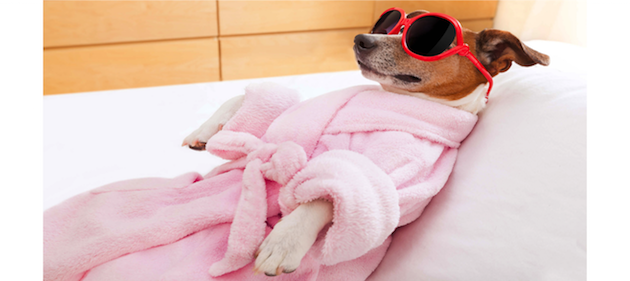
Many large veterinary practices employ certified rehabilitationists, who deliver an almost bewildering range of therapies for dogs who have suffered injury or disease affecting the muscles, bones, ligaments, or tendons of the body.
Discuss these scientifically based programs with your veterinarian to see which may benefit your dog.
Acupuncture
In veterinary acupuncture, hair-thin needles are inserted at specific points in the body. Depending on where they are inserted they can activate the central nervous system to release the body's natural painkillers (endorphins), hormones (e.g. cortisol) and neurotransmitters (e.g. serotonin).
Plenty of scientific papers have verified that acupuncture relieves pain, stimulates circulation and the immune system, decreases inflammation and relieves muscle spasms.
Gold bead implants are a permanent form of acupuncture. Tiny, pinhead sized gold beads are implanted on the acupuncture points on the dog's back and head, providing long-term stimulation of the points.
Chiropractic Treatments
Chiropractic or Veterinary Spinal Manipulative Therapy (VSMT) uses spinal manipulation to improve joint movement. It can be very beneficial for dogs that have become “misaligned” due to favoring one limb.
VSMT corrects imbalances in nerves, bones and muscles. This can alleviate pain, improve nerve health and increase muscle tone, which strengthens the joints.
Hydrotherapy
Hydrotherapy uses the buoyancy of water to reduce the weight on joints, reducing pain and allowing easier movement and exercise. Instead of stiff painful steps on land, dogs can use their full range of joint motion, improving their muscle tone and helping damaged joints to recover. Water resistance speeds the strengthening of muscles and improves cardiovascular stamina by making the heart work harder.

Hydrotherapy, using underwater treadmills or swimming, significantly improves the quality and speed of recovery from injury or surgery, accelerates joint repair, improves fitness and helps weight loss.
Therapeutic Exercises
Therapeutic exercises are designed to improve a dog’s strength, co-ordination and muscular balance, and are used to recover from injury and reduce the risk of future injuries. Balance balls, balance boards, treadmills and gait training are used in these exercises.
Passive Range of Motion Exercises (PROM)
As the name suggests, passive range-of-motion exercises are designed to improve or maintain a dog’s healthy, flexible movement. They can be used on recovering and healthy dogs to promote healthy joints.
PROM exercises are performed on a pet that is lying down on their side in a comfortable position. Limbs are gently flexed and extended one at a time. Each position is held for about 10 seconds. As the dog gains in strength the positions can be held for up to 30 seconds. These exercises are ideal for owners to use at home.
Technology
Dr McCoy from Star Trek would be impressed with the technology veterinarians may use to help their patients recovery:
- Therapeutic ultrasound
- Neuromuscular electronic stimulation
- Transcutaneous neuromuscular stimulation
- Laser therapy
- Heat or cold therapy
- Magnetic Field Therapy
- Pulsed Signal Therapy

